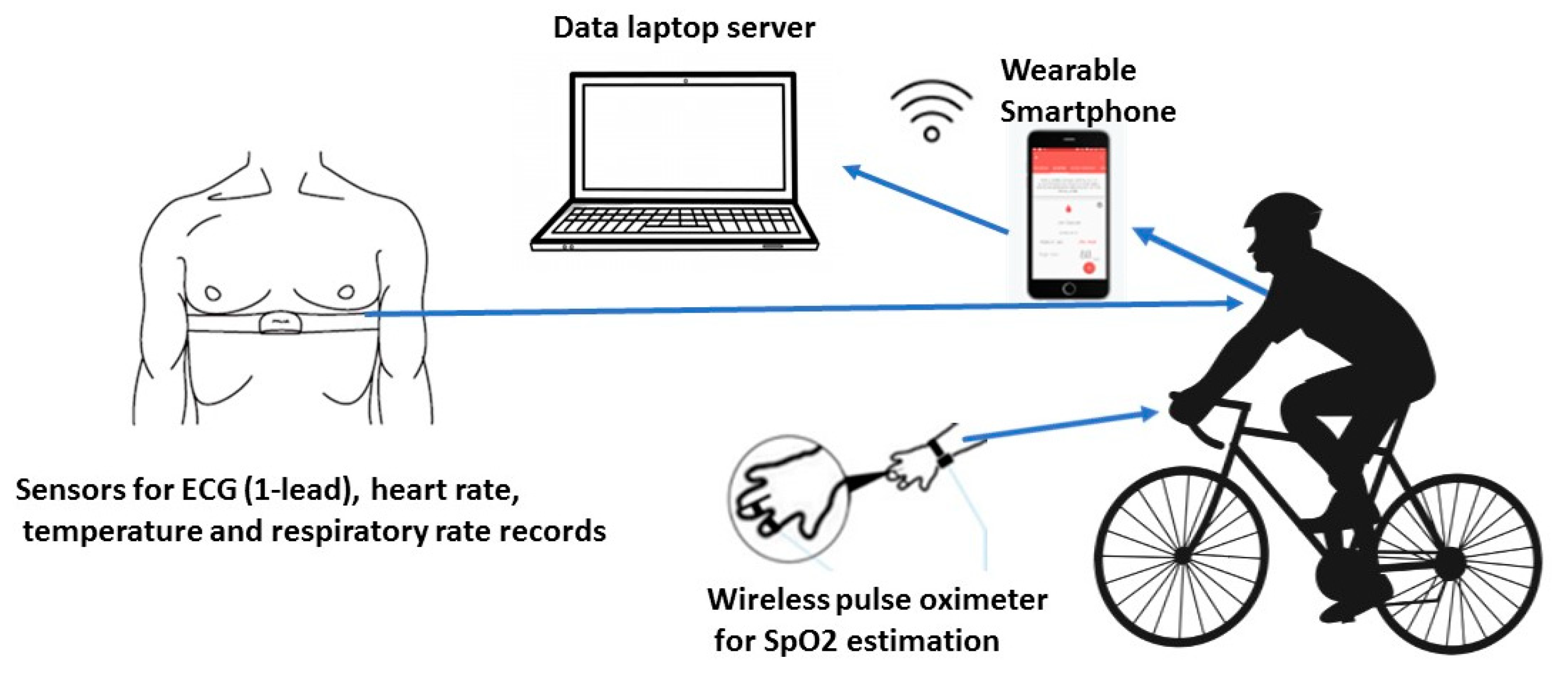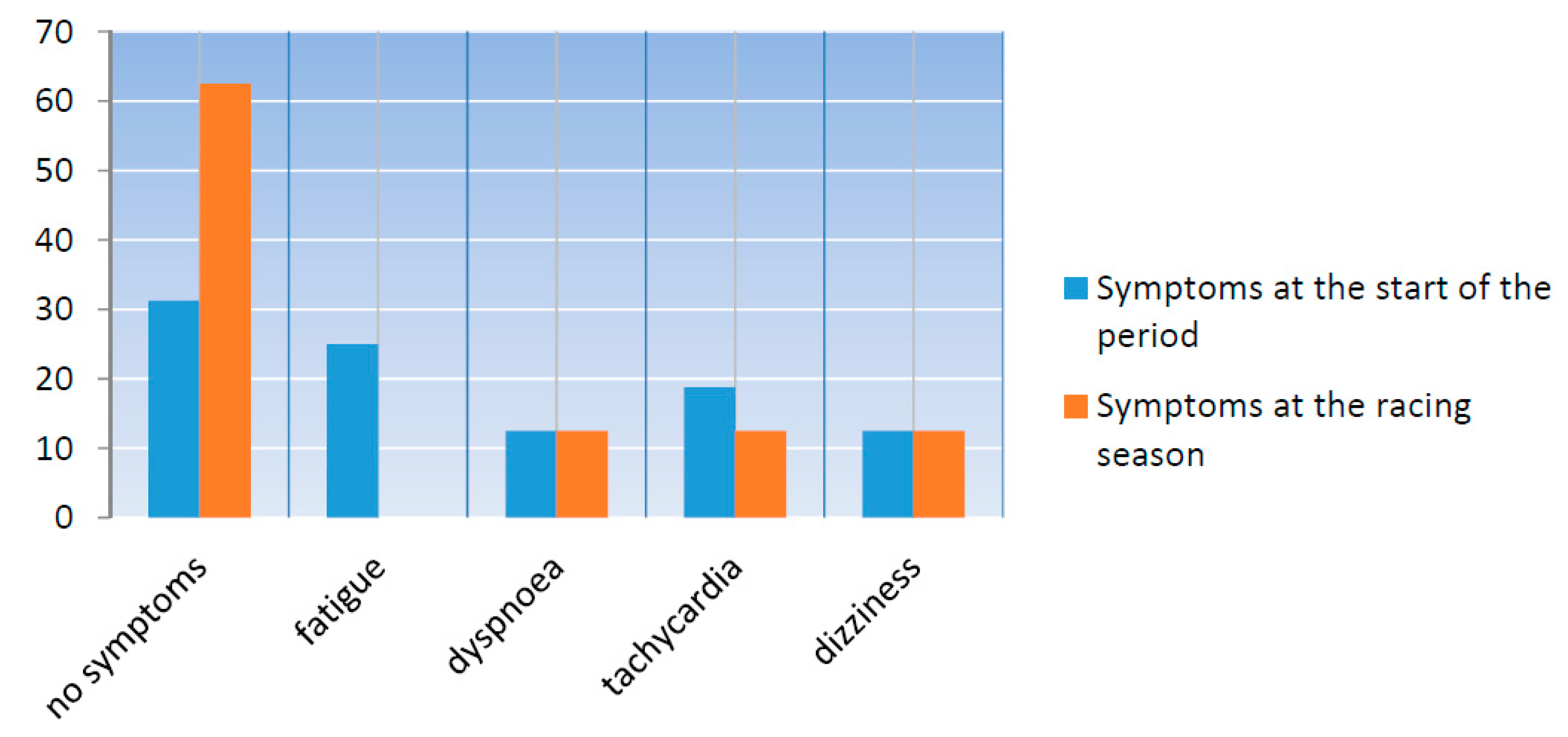A Novel mHealth Monitoring System during Cycling in Elite Athletes
Abstract
1. Introduction
2. Materials and Methods
2.1. Laboratory Measurements
2.2. mHealth Monitoring Procedure
3. Results
4. Discussion
5. Conclusions
Author Contributions
Funding
Institutional Review Board Statement
Informed Consent Statement
Data Availability Statement
Conflicts of Interest
References
- Breedt, M.; Janse van Rensburg, D.C.; Fletcher, L.; Grant, C.C.; Schwellnus, M.P. The Injury and Illness Profile of Male and Female Participants in a 94.7 Km Cycle Race: A Cross-Sectional Study. Clin. J. Sport Med. Off. J. Can. Acad. Sport Med. 2019, 29, 306–311. [Google Scholar] [CrossRef]
- Helzer-Julin, M. Sun, Heat, and Cold Injuries in Cyclists. Clin. Sports Med. 1994, 13, 219–234. [Google Scholar] [CrossRef]
- Powers, S.K.; Dodd, S.; Lawler, J.; Landry, G.; Kirtley, M.; McKnight, T.; Grinton, S. Incidence of Exercise Induced Hypoxemia in Elite Endurance Athletes at Sea Level. Eur. J. Appl. Physiol. 1988, 58, 298–302. [Google Scholar] [CrossRef] [PubMed]
- Killops, J.; Schwellnus, M.; Janse van Rensburg, D.C.; Swanevelder, S.; Jordaan, E. Medical Encounters, Cardiac Arrests and Deaths during a 109 Km Community-Based Mass-Participation Cycling Event: A 3-Year Study in 102,251 Race Starters—SAFER IX. Br. J. Sports Med. 2020, 54, 605. [Google Scholar] [CrossRef] [PubMed]
- Serrano Ostariz, E.; López Ramón, M.; Cremades Arroyos, D.; Izquierdo Álvarez, S.; Catalán Edo, P.; Baquer Sahún, C.; Legaz Arrese, A. Post-Exercise Left Ventricular Dysfunction Measured after a Long-Duration Cycling Event. BMC Res. Notes 2013, 6, 211. [Google Scholar] [CrossRef] [PubMed]
- Woodward, A.; Tin Tin, S.; Doughty, R.N.; Ameratunga, S. Atrial Fibrillation and Cycling: Six Year Follow-up of the Taupo Bicycle Study. BMC Public Health 2015, 15, 23. [Google Scholar] [CrossRef] [PubMed]
- Jordaens, L.; Missault, L.; Pelleman, G.; Duprez, D.; De Backer, G.; Clement, D.L. Comparison of Athletes with Life-Threatening Ventricular Arrhythmias with Two Groups of Healthy Athletes and a Group of Normal Control Subjects. Am. J. Cardiol. 1994, 74, 1124–1128. [Google Scholar] [CrossRef]
- Endo, M.Y.; Shimada, K.; Miura, A.; Fukuba, Y. Peripheral and Central Vascular Conductance Influence on Post-Exercise Hy-potension. J. Physiol. Anthropol. 2012, 31, 32. [Google Scholar] [CrossRef] [PubMed]
- Felig, P.; Cherif, A.; Minagawa, A.; Wahren, J. Hypoglycemia during Prolonged Exercise in Normal Men. N. Engl. J. Med. 1982, 306, 895–900. [Google Scholar] [CrossRef]
- Deligiannis, P.; Deligiannis, A.-S.; Kouidi, E. Trends in E-Health Monitoring Implementation in Sports. Sport Prav. 2011, 41, 34–37. [Google Scholar] [CrossRef]
- do Nascimento, L.M.S.; Bonfati, L.V.; Freitas, M.L.B.; Mendes Junior, J.J.A.; Siqueira, H.V.; Stevan, S.L. Sensors and Systems for Physical Rehabilitation and Health Monitoring—A Review. Sensors 2020, 20, 4063. [Google Scholar] [CrossRef] [PubMed]
- Skarbalius, A.; Vidunaite, G.; Kniubaite, A.; Reklaitiene, D.; Simanavicius, A. Importance of Sport Performance Monitoring for Sports Organization. Transform. Bus. Econ. 2019, 18, 279–303. [Google Scholar]
- Dallinga, J.; Janssen, M.; van der Werf, J.; Walravens, R.; Vos, S.; Deutekom, M. Analysis of the Features Important for the Effectiveness of Physical Activity-Related Apps for Recreational Sports: Expert Panel Approach. JMIR MHealth UHealth 2018, 6, e143. [Google Scholar] [CrossRef] [PubMed]
- Gorski, M.A.; Mimoto, S.M.; Khare, V.; Bhatkar, V.; Combs, A. Real-Time Digital Biometric Monitoring during Elite Athletic Competition: System Feasibility with a Wearable Medical-Grade Sensor. Digit. Biomark. 2021, 5, 37–43. [Google Scholar] [CrossRef] [PubMed]
- Kolsung, E.B.; Ettema, G.; Skovereng, K. Physiological Response to Cycling With Variable versus Constant Power Output. Front. Physiol. 2020, 11, 1098. [Google Scholar] [CrossRef]
- Samaras, T.; Karavasiliadou, S.; Kouidi, E.; Sahalos, J.N.; Deligiannis, A. Transtelephonic Electrocardiographic Transmission in the Preparticipation Screening of Athletes. Int. J. Telemed. Appl. 2008, 2008, 217909. [Google Scholar] [CrossRef]
- Kouidi, E.; Farmakiotis, A.; Kouidis, N.; Deligiannis, A. Transtelephonic Electrocardiographic Monitoring of an Outpatient Cardiac Rehabilitation Programme. Clin. Rehabil. 2006, 20, 1100–1104. [Google Scholar] [CrossRef]
- Mubashir, M.; Shao, L.; Seed, L. A Survey on Fall Detection: Principles and Approaches. Neurocomputing 2013, 100, 144–152. [Google Scholar] [CrossRef]
- Seshadri, D.R.; Li, R.T.; Voos, J.E.; Rowbottom, J.R.; Alfes, C.M.; Zorman, C.A.; Drummond, C.K. Wearable Sensors for Moni-toring the Internal and External Workload of the Athlete. NPJ Digit. Med. 2019, 2, 71. [Google Scholar] [CrossRef]
- Uddin, M.Z.; Khaksar, W.; Torresen, J. Ambient Sensors for Elderly Care and Independent Living: A Survey. Sensors 2018, 18, 2027. [Google Scholar] [CrossRef]
- Jung, S.; Cho, Y.; Kim, D.; Chang, M. Moving Object Detection from Moving Camera Image Sequences Using an Inertial Measurement Unit Sensor. Appl. Sci. 2020, 10, 268. [Google Scholar] [CrossRef]
- Castaneda, D.; Esparza, A.; Ghamari, M.; Soltanpur, C.; Nazeran, H. A Review on Wearable Photoplethysmography Sensors and Their Potential Future Applications in Health Care. Int. J. Biosens. Bioelectron. 2018, 4, 195–202. [Google Scholar] [CrossRef]
- Chen, Y.-C.; Peng, W.-C.; Lee, S.-Y. Mining Temporal Patterns in Time Interval-Based Data. IEEE Trans. Knowl. Data Eng. 2015, 27, 3318–3331. [Google Scholar] [CrossRef]
- De Brouwer, M.; Ongenae, F.; Daneels, G.; Municio, E.; Famaey, J.; Latré, S.; De Turck, F. Personalized Real-Time Monitoring of Amateur Cyclists on Low-End Devices; ACM Press: New York, NY, USA, 2018; pp. 1833–1840. [Google Scholar]
- Municio, E.; Daneels, G.; De Brouwer, M.; Ongenae, F.; De Turck, F.; Braem, B.; Famaey, J.; Latré, S. Continuous Athlete Mon-itoring in Challenging Cycling Environments Using IoT Technologies. IEEE Internet Things J. 2019, 6, 10875–10887. [Google Scholar] [CrossRef]
- Gaidos Rosero, O.F.; Santos, I. Mobile System of Monitoring and Training Cyclists with Smartphone. In VI Latin American Congress on Biomedical Engineering CLAIB 2014, Paraná, Argentina 29, 30–31 October 2014; Springer: Cham, Switzerland, 2015; Volume 49, pp. 59–62. ISBN 978-3-319-13116-0. [Google Scholar]
- Aroganam, G.; Manivannan, N.; Harrison, D. Review on Wearable Technology Sensors Used in Consumer Sport Applications. Sensors 2019, 19, 1983. [Google Scholar] [CrossRef]
- Lee, Y.; Jeong, J. Design and Implementation of Monitoring System Architecture for Smart Bicycle Platform. Procedia Comput. Sci. 2018, 134, 464–469. [Google Scholar] [CrossRef]
- Wundersitz, D.; Williamson, J.; Nadurata, V.; Nolan, K.; Lavie, C.; Kingsley, M. The Impact of a 21-Day Ultra-Endurance Ride on the Heart in Young, Adult and Older Adult Recreational Cyclists. Int. J. Cardiol. 2019, 286, 137–142. [Google Scholar] [CrossRef] [PubMed]
- Thompson, P.D.; Franklin, B.A.; Balady, G.J.; Blair, S.N.; Corrado, D.; Estes, N.A.M.; Fulton, J.E.; Gordon, N.F.; Haskell, W.L.; Link, M.S.; et al. Exercise and Acute Cardiovascular Events Placing the Risks into Perspective: A Scientific Statement from the American Heart Association Council on Nutrition, Physical Activity, and Metabolism and the Council on Clinical Cardiology. Circulation 2007, 115, 2358–2368. [Google Scholar] [CrossRef] [PubMed]
- Vicent, L.; Ariza-Solé, A.; González-Juanatey, J.R.; Uribarri, A.; Ortiz, J.; López de Sá, E.; Sans-Roselló, J.; Querol, C.T.; Codina, P.; Sousa-Casasnovas, I.; et al. Exercise-Related Severe Cardiac Events. Scand. J. Med. Sci. Sports 2018, 28, 1404–1411. [Google Scholar] [CrossRef] [PubMed]
- Roi, G.S.; Tinti, R. Requests for Medical Assistance during an Amateur Road Cycling Race. Accid. Anal. Prev. 2014, 73, 170–173. [Google Scholar] [CrossRef]
- Pommering, T.L.; Manos, D.C.; Singichetti, B.; Brown, C.R.; Yang, J. Injuries and Illnesses Occurring on a Recreational Bicycle Tour: The Great Ohio Bicycle Adventure. Wilderness Environ. Med. 2017, 28, 299–306. [Google Scholar] [CrossRef]
- McGrath, T.M.; Yehl, M.A. Injury and Illness in Mountain Bicycle Stage Racing: Experience from the Trans-Sylvania Mountain Bike Epic Race. Wilderness Environ. Med. 2012, 23, 356–359. [Google Scholar] [CrossRef] [PubMed]
- Buck, D.; McNaughton, L.R. Changing the Number of Submaximal Exercise Bouts Effects Calculation of MAOD. Int. J. Sports Med. 1999, 20, 28–33. [Google Scholar] [CrossRef] [PubMed]
- Martinez, J.M. Medical Coverage of Cycling Events. Curr. Sports Med. Rep. 2006, 5, 125–130. [Google Scholar] [CrossRef] [PubMed]


| Age (years) | 24.1 ± 4.5 |
| Weight (Kg) | 76.0 ± 6.9 |
| Height (cm) | 179.3 ± 5.2 |
| ΒΜΙ | 23.3 ± 1.5 |
| Years of training (years) | 5.6 ± 1.9 |
| Frequency of training (times/week) | 5.3 ± 0.9 |
| Heart rate at rest (b/min) | 56.2 ± 5.5 |
| Systolic blood pressure at rest (mm/Hg) | 125.8 ± 8.4 |
| Diastolic blood pressure at rest (mm/Hg) | 73.8 ± 10.0 |
| Physiological Parameters | Beginning of Training Period | Racing Season |
|---|---|---|
| Heart Rate at rest (b/min) | 71.4 ± 6.5 | 68.6 ± 8.7 |
| Systolic Blood Pressure at rest (mm/Hg) | 126.8 ± 7.1 | 125.8 ± 6.5 |
| Diastolic Blood Pressure at rest (mm/Hg) | 76.6 ± 9.4 | 75.7 ± 7.8 |
| Heart Rate max (b/min) | 195.7 ± 9.6 | 195.4 ± 10.0 |
| Systolic Blood Pressure max (mm/Hg) | 195.4 ± 6.4 | 194 ± 3.9 |
| Diastolic Blood Pressure max (mm/Hg) | 72.6 ± 2.9 | 71.8 ± 2.3 |
| Time to fatigue (min) | 11.69 ± 1.8 | 13.72 ± 1.3 * |
| Max Power (Watts) | 354.7 ± 46.7 | 403.1 ± 30.1 * |
| HRVT (b/min) | 176.6 ± 8.7 | 175.6 ± 9.6 |
| VO2max (mL/kg/min) | 55.4 ± 5.3 | 63.4 ± 6.9 * |
| Physiological Parameters | Start of the Training Period | Racing Season | ||
|---|---|---|---|---|
| Rest | Μax | Rest | Μax | |
| Systolic Blood Pressure (mm/Hg) | 131.2 ± 8.8 | 148.3 ± 13.6 | 130.8 ± 7.5 | 147.5 ± 8.3 |
| Diastolic Blood Pressure (mm/Hg) | 77.8 ± 9.4 | 76.3 ± 6.3 | 78 ± 8.5 | 77.8 ± 8.7 |
| Heart Rate (b/min) | 68.4 ± 6.4 | 165.6 ± 6.6 | 67.8 ± 6.2 | 163.6 ± 8.4 |
| Hemoglobin (g/dL) | 15.4 ± 1.5 | 14.5 ± 1.4 a | 15.2 ± 1.3 | 14.7 ± 1.2 b |
| Hematocrit (%) | 46.2 ± 4.5 | 43.4 ± 4.1 a | 45.5 ± 3.8 | 44.2 ± 3.8 b |
| Glucose (mg/dL) | 105.3 ± 8.4 | 100.7 ± 8.6 a | 99.8 ± 6.4 c | 94.8 ± 5.7 b |
| Oxygen saturation | 99.1 ± 0.7 | 96.4 ± 0.6 a | 98.7 ± 0.7 c | 96.9 ± 0.8 b |
Publisher’s Note: MDPI stays neutral with regard to jurisdictional claims in published maps and institutional affiliations. |
© 2021 by the authors. Licensee MDPI, Basel, Switzerland. This article is an open access article distributed under the terms and conditions of the Creative Commons Attribution (CC BY) license (https://creativecommons.org/licenses/by/4.0/).
Share and Cite
Iliadis, A.; Tomovic, M.; Dervas, D.; Psymarnou, M.; Christoulas, K.; Kouidi, E.J.; Deligiannis, A.P. A Novel mHealth Monitoring System during Cycling in Elite Athletes. Int. J. Environ. Res. Public Health 2021, 18, 4788. https://doi.org/10.3390/ijerph18094788
Iliadis A, Tomovic M, Dervas D, Psymarnou M, Christoulas K, Kouidi EJ, Deligiannis AP. A Novel mHealth Monitoring System during Cycling in Elite Athletes. International Journal of Environmental Research and Public Health. 2021; 18(9):4788. https://doi.org/10.3390/ijerph18094788
Chicago/Turabian StyleIliadis, Alexandros, Milena Tomovic, Dimitrios Dervas, Markella Psymarnou, Kosmas Christoulas, Evangelia Joseph Kouidi, and Asterios Pantazis Deligiannis. 2021. "A Novel mHealth Monitoring System during Cycling in Elite Athletes" International Journal of Environmental Research and Public Health 18, no. 9: 4788. https://doi.org/10.3390/ijerph18094788
APA StyleIliadis, A., Tomovic, M., Dervas, D., Psymarnou, M., Christoulas, K., Kouidi, E. J., & Deligiannis, A. P. (2021). A Novel mHealth Monitoring System during Cycling in Elite Athletes. International Journal of Environmental Research and Public Health, 18(9), 4788. https://doi.org/10.3390/ijerph18094788






